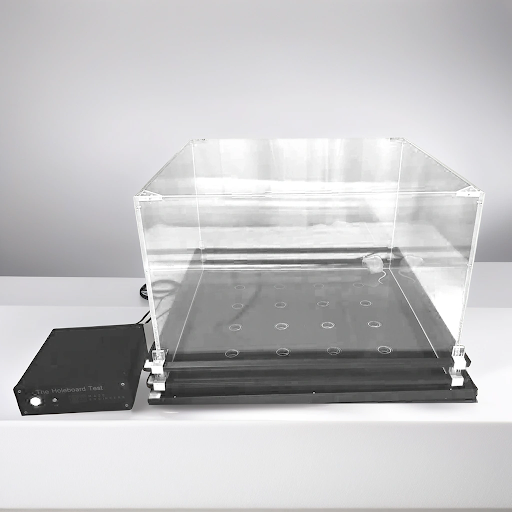
Description
The General Rodent Activity System is an automated system used to observe, record, and analyze rodents’ locomotor and behavioral activity levels. The Activity System consists of an open field box, surrounded by an outer area divided into quadrants with the activity integration that reports the animal location. It is an adapted version of the Open Field arena and Hole Board apparatus and also includes sensors for recording and software for analyzing rodents’ behavior. It can measure the subject’s locomotion, behavioral activity levels, for behaviors associated with anxiety, exploration, thigmotaxis, and working and reference memory.
It can be used to assess the effect of age on locomotion, neuromuscular abnormalities of genetically modified animals, the effect of therapeutic interventions on locomotion and behavior, etc.
The system includes the Activity Hole Board.
Price and Specifications
Mouse
$ 4990
Per Month- 40 x 40 x 30 cm (L x W x H)
- 16 holes, 2cm diameter
Rat
$ 5490
Per Month- 60 x 60 x 40 cm (L x W x H)
- 16 holes, 3cm diameter
How it works
Documentation
Introduction
The Activity System is an automated system used to observe, record, and analyze rodents’ locomotor and behavioral activity levels. The system is an adapted version of the Open Field arena and Hole Board apparatus and also includes software for analyzing rodents’ behavior. It can report the animal’s location and records when an animal moves with a jump and without a jump. Moreover, the experimenter can set a time interval for recording the number of jumps in a given time period, which is illustrated in a “Jump Chart”. The software also provides a visual illustration of the animal’s locomotion during each trial.
The open-field arena is a widely used apparatus for assessing rodents’ locomotion, exploratory behavior, and anxiety. The hole board apparatus is also used to assess exploratory behaviors in rodents but also assesses working and reference memory. The activity system combines both apparatuses and includes software for analyzing and measuring rodents’ behavior, which helps save time from manual observation and analysis. The holes in the activity system floor also include sensors to record which hole the subject pokes its nose, and the duration of the nose pokes.
The activity system can effectively be used as an in vivo locomotion assay for various experiments. It can be used to assess the effect of age on locomotion behavior, neuromuscular abnormality of genetically modified animals, anxiety-related behaviors on behavioral activity levels, neurodegenerative diseases on working and reference memory, and the effect of therapeutic interventions on locomotion and behavior.
Apparatus and Equipment
The Activity System comprises an open field arena. It is available with separate measurements for rats and mice. It measures 60 × 60 × 40 cm (L × W × H) for rats and 40 × 40 × 30 cm for mice. The floor of the arena contains 16 holes spaced evenly apart. The diameter for each hole is 3 cm for rats and 2 cm for mice. The sensor’s height within each hole is adjustable. The walls of the arena are made of plexiglass.
It also includes software to measure and record the animal’s location and make a visual drawing of the activity data.
Installation
Training Protocol
- Place the subjects in the testing room in their home cages for 10 – 30 minutes to acclimate.
- Configure the software and set the primary data collection parameters.
- Remove the subject from its home cage and place it in the activity system once the software is configured.
- Select the appropriate command in the software and begin data collection.
- Leave the testing room for the rest of the testing duration.
- After the testing period is completed, return to the room and save the data.
- Return the subject to its home cage.
Literature Review
Analysis of Locomotor Activity in Rodents
Zhang, Li, and Han (2020) analyzed the locomotor activity of mice using an activity system. The system comprised an open field, a webcam, and a computer with software. The distance traveled, velocity, and thigmotaxis of the animals were readily obtained using the apparatus.
Aragão et al. (2011) analyzed locomotor activity in rodents using an automated activity system. The system consisted of an open field with 30 cm high walls. It utilized digital images captured under infrared red of freely moving rodents to measure their activity. Moreover, videos of the rodents were analyzed using the software. Fifteen male Wistar rats were used in the study. The distance traveled, average speed, average potency, time spent immobile, number of stops, and length of stay in the area of the subjects within the apparatus were recorded. The animals were evaluated on multiple postnatal days to investigate the study’s reproducibility. The results indicated that all parameters were effectively measured using the system. Moreover, development changes in the patterns of movement in the subjects were also observed across postnatal days.
Summary
- The Activity System is an automated system used to observe, record, and analyze rodents’ locomotor and behavioral activity levels.
- It is an adapted version of the Open Field arena and Hole Board apparatus and also includes sensors for recording and software for analyzing rodents’ behavior.
- It can measure the subject’s locomotion, behavioral activity levels, anxiety, exploration, thigmotaxis, and working and reference memory.
- The system can be used to assess the effect of age on locomotion, neuromuscular abnormalities of genetically modified animals, the effect of therapeutic interventions on locomotion and behavior etc.
References
Aragão, R., Rodrigues, M. A., de Barros, K. M., Silva, S. R., Toscano, A. E., de Souza, R. E., & Manhães-de-Castro, R. (2011). Automatic system for analysis of locomotor activity in rodents–a reproducibility study. Journal of neuroscience methods, 195(2), 216–221. https://doi.org/10.1016/j.jneumeth.2010.12.016
Zhang, C., Li, H., & Han, R. (2020). An open-source video tracking system for mouse locomotor activity analysis. BMC research notes, 13(1), 48. https://doi.org/10.1186/s13104-020-4916-6


